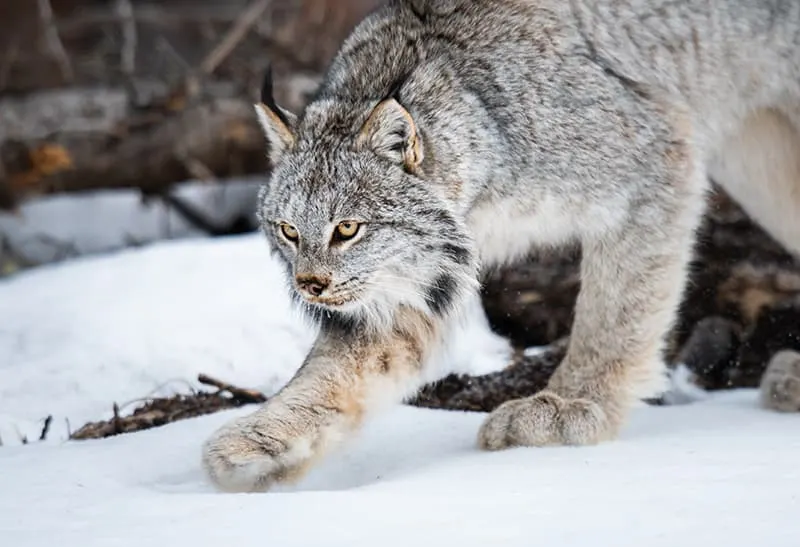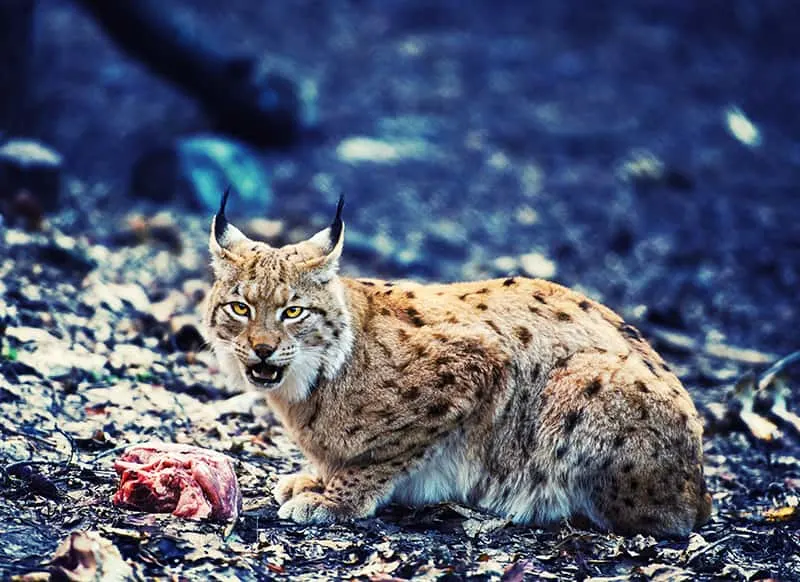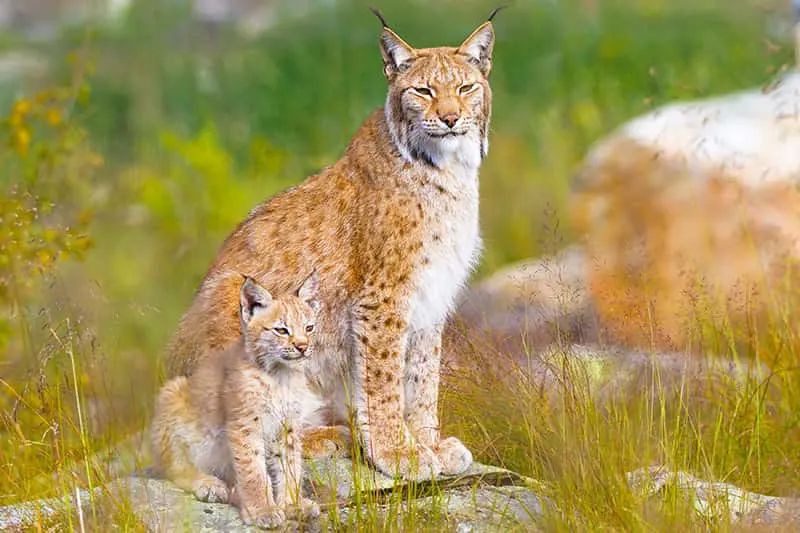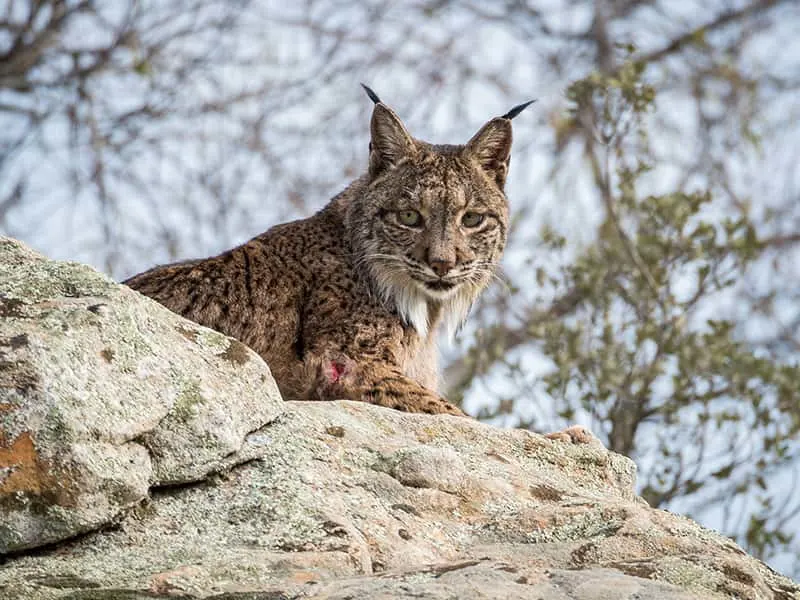Do you want to learn some awesome lynx facts for kids? Learn all about lynx in this post. We will be talking about their physical description, habitat, offspring, and more!

There are four species of lynx. The Bobcat, the Canadian lynx, the Eurasian lynx, and the Iberian lynx.
The Canadian lynx, the Eurasian lynx, and the Iberian lynx will be talked about here.
Physical Description
Lynxes have broad faces, golden eyes, short snouts, whiskers, long legs, and large paws. Lynxes can look different from each other, but they all have short tails and tufted ears. Lynx ears have extra black hair that grows at the tips. Lynxes range in color from medium brown to light beige. Their fur is lighter on their bellies and the insides of their legs. Some lynx have spots.
A lynx can weigh anywhere between twenty-four and sixty-six pounds. The Canadian lynx is the smallest lynx of the three, weighing about twenty-four pounds. The Iberian lynx can weigh up to twenty-eight pounds. The Eurasian lynx is the largest and can weigh up to sixty-six pounds.
The Iberian and Canadian lynx both grow to be about three and a half feet long. The Eurasian lynx can grow to be almost four and a half feet long.
Habitat
The Eurasian lynx has the widest distribution of all the lynxes. They can be found across Europe and Central Asia, Siberia, and East Asia. They have a range of habitats as well. They live in forests, semi-desert areas, and rocky areas.
The Canadian lynx lives in the colder regions of the boreal forests of Canada and the United States. Canadian lynxes can be found in Canada, Alaska, the Cascade and Rocky Mountain ranges, the Great Lakes area, and Maine.

The Iberian lynx is only found in two areas of the Iberian Peninsula. It lives in the woodlands and scrub habitats of Southern Spain.
Habits
Lynx are typically solitary creatures, but they sometimes form small groups to hunt and travel. Mostly nocturnal, they are most active at the hours of dusk and dawn. They spend most of the day resting in brush, trees, and tall grass.
Lynx are territorial. They travel across their territory in search of prey to eat. Male lynxes do not share territories. The territories of male and female lynxes can overlap. Male lynxes usually travel further than female lynxes to hunt.
The Iberian lynx has a territory of about twelve miles.
The Eurasian and Canadian lynx have been known to travel much farther than the Iberian lynx. The Eurasian lynx can cover more than fifteen hundred miles.
The Canadian lynx has been known to migrate two thousand miles. Canadian lynx don't migrate for winter. Scientists are unsure but suspect these lynxes may migrate for food. Canadian lynx have also been known to migrate to a different type of habitat in search of prey.
Diet
All lynxes are carnivores. The Canadian lynx is reliant on the snowshoe hare as its primary food source. Iberian lynxes also hunt rabbits, but rabbits aren’t their main source of food. Iberian lynxes also eat ducks and young deer.
Eurasian lynxes prefer hooved mammals and mainly eat deer, elk, and caribou. Most lynxes supplement their diet with small rodents and birds.

Offspring
Female lynxes are pregnant for about two and a half months. Mama lynxes give birth to kittens in a den. They typically have a litter of two to three kittens. When lynx kittens are born, they weigh between seven and eight and a half ounces.
Canadian lynx have the smallest kittens, and Eurasian lynx have the largest. Lynx kittens are born with closed eyes, folded ears, and downy fur. Their eyes open and their ears unfold at about three weeks old. By six weeks old, their adult fur has grown in, and they can regulate their body temperature.

As lynx kittens mature into juveniles, the mother teaches them to hunt. Lynx kittens become independent around one year old.
Classification/Taxonomy
Kingdom: | Animalia
Phylum: | Chordata
Class: | Mammalia
Order: | Carnivora
Family: | Felidae
Genus: | Lynx
History
Lynx issiodorensis is the ancestor of the lynx species. This ancestor first appeared about four million years ago in North America before expanding to other continents.
Predators
Predators of Canadian lynxes include wolves, fishers, bobcats, cougars, and coyotes. Tigers, wolves, and wolverines sometimes kill Eurasian lynx. Iberian lynx don’t have natural predators.
Lifespan
In the wild, the Canadian lynx can live up to fourteen years and the Eurasian lynx can live up to seventeen years. The longest a Canadian lynx has lived in captivity is twenty-six years. The Eurasian lynx has lived up to twenty-five years in captivity.
The Iberian lynx can live up to thirteen years in the wild or in captivity.

What Sound Does a Lynx Make?
Check out this audio file to hear what sound a lynx makes.
25+ Unusual Lynx Facts for Kids
- The scientific name of a Canadian lynx is Lynx canadensis.
- The scientific name of an Eurasian lynx is Lynx lynx.
- The scientific name of an Iberian lynx is Lynx pardinus.
- The Iberian lynx is the world’s most endangered cat species.
- Lynxes’ ear tufts function similarly to hearing aids. Tufts allow a lynx to hear better.
- A lynx can spot a mouse from 250 feet away due to its excellent eyesight.
- Eurasian lynxes are adapted to eat animals that are much larger than they are.
- Iberian lynxes are listed as “critically endangered” on the IUCN Red List.
- Canadian and Eurasian lynxes are listed as “least concern” on the IUCN Red List.
- Lynxes spend most of their time on the ground, but they are great climbers.
- Lynxes are good swimmers and are known to catch fish to eat.
- Lynx make sounds that are similar to housecats. They mew, hiss, purr, yowl, and growl.
- When a lynx turns one year old, it leaves its mom to find its own territory.
- A lynx can jump 25 feet.
- Lynx paws are special because they can spread out their paws to make it easier to walk in deep snow.
- The smaller the population of snowshoe hares, the fewer Canadian lynx there are.
- The lynx population has 50,000 breeding members worldwide.
- A lynx is any of the four species of medium-sized wild cats from the Lynx genus.
- The average lifespan of a lynx is about 15 years.
- A lynx can run up to fifty miles an hour.
- A blue lynx is a lynx with a genetic mutation that gives its lighter fur hues a slight blue tint.
- A lynx’s paws are bigger than a mountain lion’s paws.
- Lynxes’ hind legs are longer than their front legs.
- Lynxes are sometimes called “ghosts of the forest” because they are stealthy like ninjas.
- The name “lynx” comes from the Greek word for “bright”. This refers to the lynx’s eyes.
- Lynxes can’t roar.
- Lynxes can hear a mouse’s movements from over fifty yards away.
We hope you had fun learning all about lynxes! Did you discover any new facts? Let us know what other facts you know about lynxes. We’d love to hear more!
